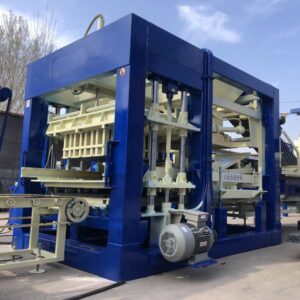
The construction industry stands at the crossroads of innovation and necessity, poised to shape a future that is both functional and sustainable.
At the heart of this transformation lies the remarkable evolution of block making machines, the unsung heroes of modern construction.
These machines, with their intricate technology and precision engineering, are quietly revolutionizing the way we build, paving the way for a future where efficiency, sustainability, and performance seamlessly converge.
This essay delves into the captivating world of high-performance block making machines, shedding light on their technological intricacies, operational processes, advanced features, and the profound impact they hold in shaping the architecture of tomorrow.
The Technological Canvas: Anatomy of High-Performance Block Making Machines
Precision Engineering: High-performance block making machines are the result of meticulous precision engineering.
Every component, from the molds to the hydraulic and pneumatic systems, is designed with exacting standards to ensure consistent quality and structural integrity of the blocks produced.
Computer-Aided Design and Manufacturing (CAD/CAM): Cutting-edge block making machines leverage CAD/CAM technology to create intricate molds and dies.
This enables architects and builders to explore diverse design possibilities, from modular interlocking blocks to innovative surface textures, all while maintaining accuracy and reproducibility.
Automation and Control Systems: The heart of high-performance block making machines beats with advanced automation and control systems.
These systems orchestrate the entire production process, precisely measuring raw materials, orchestrating the mixing process, and governing the compaction and curing stages.
Real-time monitoring and adjustment ensure uniformity and adherence to quality standards.
Operation Unveiled: Journey from Raw Materials to Finished Blocks
Material Preparation and Mixing: The journey begins with the careful preparation of raw materials – aggregates, cement, and water – to form a homogenous mixture.
High-performance block making machines employ innovative measuring systems to ensure the exact proportions of each ingredient, contributing to the uniformity and strength of the blocks.
Compaction and Shaping: The mixed materials are then fed into molds or chambers, where hydraulic or pneumatic systems apply precise pressure to compact and shape them.
This process eliminates voids, ensures structural integrity, and defines the final dimensions of the blocks.
Curing Techniques: Curing, a critical step in block production, enhances the strength and durability of the blocks.
High-performance machines deploy advanced curing techniques, such as steam curing or high-frequency vibration, to expedite the curing process while minimizing energy consumption.
Advancing the Possibilities: Innovative Features and Customization
Material Innovation: High-performance block making machines embrace the concept of sustainable construction by incorporating alternative and eco-friendly materials.
These machines can use industrial byproducts like fly ash or incorporate recycled aggregates, reducing the environmental impact of construction.
Customization Beyond Boundaries: The realm of customization knows no limits with high-performance machines.
Architects and builders can create blocks with unique surface finishes, intricate patterns, and modular designs that enhance aesthetics while serving functional purposes like improved insulation or passive ventilation.
Versatility in Block Types: These machines have the capacity to produce a wide range of block types, from standard rectangular units to specialized shapes for enhanced load-bearing or decorative purposes.
This versatility equips architects with the tools to explore innovative architectural designs.
A Sustainable Future Built Block by Block
Resource Efficiency: The meticulous precision of high-performance block making machines minimizes material wastage, contributing to responsible resource management.
The accurate material measurements and efficient compaction techniques reduce the need for excess materials, aligning with sustainable construction principles.
Energy Efficiency: The incorporation of advanced curing techniques, coupled with precise automation, results in reduced energy consumption during block production.
This energy efficiency not only lowers operational costs but also contributes to a lower carbon footprint.
Durability and Longevity: The blocks produced by high-performance machines boast enhanced durability and longevity, reducing the need for frequent replacements.
This resilience translates to long-term sustainability, as fewer resources are consumed over the life cycle of a structure.
Challenges and Future Frontiers
While high-performance block making machines offer remarkable benefits, their accessibility to all corners of the construction industry may be hindered by technological barriers.
Efforts to bridge the digital divide and make these machines more accessible to a wider range of construction professionals are essential.
The operation and maintenance of high-performance block making machines demand a skilled and knowledgeable workforce.
Training programs and educational initiatives are imperative to ensure that professionals can effectively harness the potential of these machines.
In conclusion, the evolution of high-performance block making machines transcends the boundaries of conventional construction.
Their intricate technology, precision engineering, and innovative features are redefining the very essence of building.
As architects and builders lay the foundations for the future, these machines provide a blueprint for progress that marries efficiency, sustainability, and performance.
With every block that is meticulously shaped and cured, these machines contribute to a world where construction is not just about erecting structures but about shaping a sustainable and vibrant future, one block at a time.
